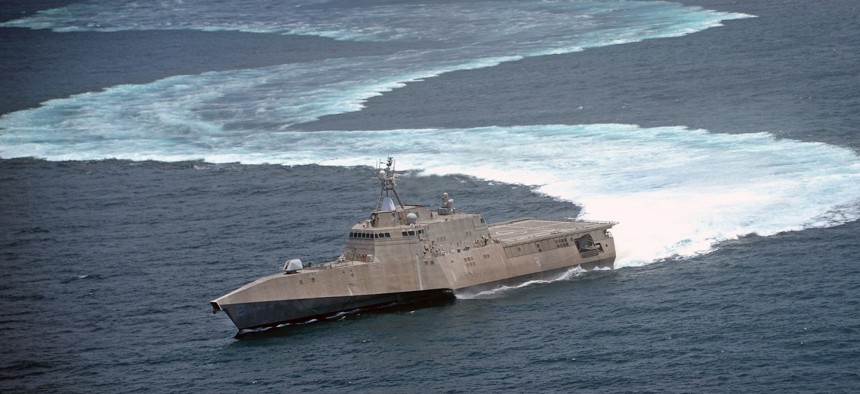The US Navy Has Drifted Badly Off Course
Three main failures are imperiling the sea service, writes the service’s former chief learning officer.
During the past year, I worked in the E-Ring of the Pentagon as the Navy’s chief learning officer, reporting directly to the secretary of the Navy. For much of that time, I attended the secretary’s senior staff meetings and participated in periodic intelligence and war games briefings. I was deeply impressed with the professionalism and integrity of the men and women with whom I served. I was disturbed, however, by many signs that under the Trump administration, the Navy has drifted badly off course.
Over the last four years, the Navy’s civilian leaders have failed to define a compelling vision for the Navy’s future, reform a badly broken ship design and acquisition system, or build a diverse, high-performing leadership team. These failures – caused, in part, by rapid turnover in leadership, with five different Secretaries or acting Secretaries of the Navy serving on average for only nine months — have damaged Navy effectiveness, undercut morale, and jeopardized national security.
The primary naval responsibility of every administration is to define the navy the United States will need in coming decades to protect national security. This strategic vision is developed and shared publicly through a process called “future force assessment.” The current administration has utterly failed to meet this responsibility. The most recent Navy force assessment was issued in 2016, during the Obama administration. Since that time, we have seen the development of remotely controlled drone naval vessels and subs, a new National Defense Strategy, and the rise of Chinese naval power. These events have rendered the 2016 assessment obsolete, but no new blueprint has been issued. The Navy completed a classified draft in 2019, which I analyzed at the request of then-Acting Secretary of the Navy Thomas Modly, but that effort and its associated ship-building plan died on the drafting table, widely criticized inside the Pentagon for unrealistic assumptions and flawed analysis. In response, Defense Secretary Mark Esper stripped the Navy of its responsibility to design our future navy and assigned the task to his staff, an unprecedented development reflecting total lack of faith in the service’s leaders and its strategic planning capability. As a result, the Navy – our nation’s experts on naval combat and strategy – has lost the power to define its own future.
The Navy’s ship acquisition program is also struggling. If we want to maintain the world’s strongest navy in the face of aggressive Chinese construction plans, we need to acquire powerful, cost-effective manned and unmanned ships in significant quantities. The last three major surface warship programs, however, have been disasters. The construction of the USS Ford aircraft carrier has been plagued with delays, cost overruns, and technology failures. The hyper-expensive Zumwalt-class destroyer program was cancelled after construction of three prototypes, not the 30 originally planned, because the costly ships serve no clear naval purpose. And the littoral combat ships, dubbed the “Little Crappy Ships” by some sailors, are being decommissioned decades ahead of schedule because their maintenance and upgrade costs far outweigh their limited military value. These failures have resulted in a remarkable development in this highly partisan era: a call from the top Senators of both political parties on the Senate Armed Forces Committee for reform. Despite this abysmal track record, the Navy’s civilian leaders have not made any fundamental changes to our acquisition system or ordered a high-level review to identify a better way forward.
Finally, the administration has failed to develop a diverse, high-performing leadership team. Today, the secretary, under secretary, all three assistant secretaries, the chief and vice chief of naval operations, the master chief petty officer of the Navy, chief information officer, and chief management officer are all white, and all but two are men. In senior meetings in the E-Ring, the overwhelming majority of participants are white males. African-Americans comprise 17 percent of the enlisted force, but only 5 percent of the admirals. If you believe that diversity of viewpoint and experience improves decision-making, this should concern you. We need a Navy leadership team that draws upon the entire diverse strength of our nation.
To fix these problems, the Navy needs to implement a series of fundamental reforms. The Department of the Navy needs to create a joint Navy-Marine Corps think-tank inside the department staffed by leading naval thinkers from universities, think tanks, and the uniformed services to lead and integrate strategic planning, force assessment and wargaming, so we can bring greater creativity and analytic rigor to the design of the future Navy. Instead of mindlessly repeating past acquisition mistakes, we need to empower a high-level expert panel to review recent ship design and purchasing failures in order to identify the weaknesses of our system and initiate reforms. This should include implementation of more sophisticated risk analysis and management procedures, so we can avoid the problems that have plagued the Ford, LCS, and Zumwalt programs. And we need a revolutionary commitment to diversity and inclusion, starting at the top, that changes the way we recruit, assign, promote and mentor officers and civilian executives of color.
Our sailors and Marines — and our country — deserve better. Fixing these problems is not impossible, but it will take a real commitment to change.
John Kroger is vice president at the Aspen Institute. A Marine Corps veteran, former college president, and past attorney general of Oregon, he served as chief learning officer of the Navy and Marine Corps from 2019 to 2020.




